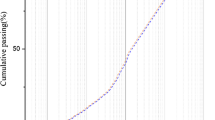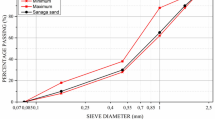Abstract
The use of glass powder instead of cement as an auxiliary cementitious material can better alleviate environmental problems and energy problems. This experiment studies the influence of the fineness of glass powder and the substitution rate on the performance of mortar, to guide the actual project. The study found that with the increase of the substitution rate, the initial setting time becomes longer, the finer the fineness, the longer the initial setting time, but the difference between P-60 and P-90 decreases with the increase of the substitution rate. With the increase of substitution rate, the compressive strength of 7, 28 and 90 d increased first and then decreased. When the substitution rate was 5%, the compressive strength reached the maximum, but the 7 d compressive strength of P-30 with 5% substitution rate decreased slightly. With the increase of substitution rate, the cumulative hydration heat decreased gradually. The difference between P-60 and P-90 was not significant. Similar to the cumulative hydration heat, the hydration heat flow per gram of cement decreased gradually with the increase of substitution rate. It can be seen from nanoindentation that fineness and substitution rate have little effect on the properties of hydration products. With the increase of substitution rate, the total porosity decreases first and then increases. The porosity of glass powder mixed with P-30 is the largest, followed by P-60 and P-90, but the difference between the total porosity of P-60 and P-90 is not significant. In practical engineering, these two factors need to be considered in combination.










Similar content being viewed by others
REFERENCES
Wang, Q., Cui, X., Wang, J., Li, S., Lv, C., and Dong, Y., Effect of fly ash on rheological properties of graphene oxide cement paste, Constr. Build. Mater., 2017, vol. 138, pp. 35–44.
Du, H. and Tan, K.H., Effect of particle size on alkali-silica reaction in recycled glass mortars, Constr. Build. Mater., 2014, vol. 66, pp. 275–285.
Shayan, A. and Xu, A., Performance of glass powder as a pozzolanic material in concrete: A field trial on concrete slabs, Cement Concrete Res., 2006, vol. 36, pp. 457–468.
Khmiri, A., Chaabouni, M., and Samet, B., Chemical behaviour of ground waste glass when used as partial cement replacement in mortars, Constr. Build. Mater., 2013, vol. 44, pp. 74–80.
Schwarz, N., DuBois, M., and Neithalath, N., Electrical conductivity based characterization of plain and coarse glass powder modified cement pastes, Cement Concrete Compos., 2007, vol. 29, pp. 656–666.
Hendi, A., Mostofinejad, D., Sedaghatdoost, A., Zohrabi, M., Naeimi, N., and Tavakolinia, A., Mix design of the green self-consolidating concrete: Incorporating the waste glass powder, Constr. Build. Mater., 2019, vol. 199, pp. 369–384.
Mirzahosseini, M., and Riding, K.A., Influence of different particle sizes on reactivity of finely ground glass as supplementary cementitious material (SCM), Cement Concrete Compos., 2015, vol. 56, pp. 95–105.
Matos, A.M., and Sousa-Coutinho, J., Durability of mortar using waste glass powder as cement replacement, Constr. Build. Mater., 2012, vol. 36, pp. 205–215.
Miranda Júnior, E.J.P.d., Bezerra, H.d.J.P.L., and Politi, F.S., Paiva, A.E.M. Increasing the compressive strength of Portland cement concrete using flat glass powder, Mater. Res., 2014, vol. 17, pp. 45–50.
Matos, A.M., Ramos, T., Nunes, S., and Sousa-Coutinho, J., Durability enhancement of SCC with waste glass powder, Mater. Res., 2016, vol. 19, pp. 67–74.
Baidzhanov, D.O., Niemen, V.N., and Bakirova, D.G., Powdered glass - active mineral addition, Izv. Vyssh. Uchebn. Zaved., Stroit., 2012, vol. 9, pp. 34–40.
No Hyoung, J., Geun, Y.I., Kim S.-M., Min, B.S., and Keun, K.Y., Mechanical properties of polymer concrete replaced with powdered waste glass, Korean Soc. Waste Manage., 2020, vol. 37, pp. 245–252.
Jang, I., An experimental study on high strength concrete using the LCD waste glass powder, Korean Recycl. Constr. Resour. Inst., 2015, vol. 3, pp. 335–341.
Liu, Y., Effects of zeolite powder and glass powder on the properties of concrete, Non-Met. Mines, 2021, vol. 44, pp. 43–46.
Zeng, C., Gan, Y., Ke, G., and Li, S., Experimental study on the mechanical property of waste glass powder concrete, Bull. Chin. Ceram. Soc., 2014, vol. 33, pp. 377–381.
Kushartomo, W., Bali, I., and Sulaiman, B., Mechanical behavior of reactive powder concrete with glass powder substitute, Civil Eng. Innov. Sustain., 2015, vol. 18, pp. 617–622.
Gan, Y., Zeng, C., Ke, G., and Li, S., Experimental study on the flexural behaviour of waste-glass-powder reinforced concrete beams, Build. Struct., 2014, vol. 44, pp. 78–81.
De Miranda, E.J.P., Bezerra, H., Politi, F.S., and Paiva, A.E.M., Increasing the compressive strength of portland cement concrete using flat glass powder, Mater. Res.-Ibero-Am. J. Mater., 2014, vol. 17, pp. 45–50.
Xiong, Z., Ke, G., Tao, W., and Zou, P., Influence of waste glass powder on fluidity of cement-based materials, J. China Powder Sci. Technol., 2021, vol. 27, pp. 80–89.
Zhao, Y., Ma, P., and Liu, L., Experimental study on mechanical properties of cement mortar mixed with different diameter-waste glass powder, J. Build. Sci., 2019, vol. 35, pp. 86–89.
Li, S., Jiao, C., and Gan, Y., Study on mechanical properties of waste glass powder concrete, J. Adv. Eng. Sci., 2019, vol. 51, pp. 199–205.
Li, L., Ren, Z., Yang, J., and Liu, S., Mechanism of waste glass powder inconcrete and its ASR risk, J. Yangtze River Sci. Res. Inst., 2016, vol. 33, pp. 94–99.
Ni, C., Tan, H., Yang, Y., Xiang, C., Chen, Z., and Li, X., Influence of glass powder on acid corrosion resistance of concrete, J. Hohai Univ. Nat. Sci., 2015, vol. 43, pp. 341–345.
Rao, M., Deng, L., and Yang, H., ASR risk and inhibition effect of mortar bar containing glass powder, J. Yangtze River Sci. Res. Inst., 2015, vol. 32, pp. 105–109.
Liu, S., Wang, L., Xie, G., and Wang, S., Hydration of cement paste containing glass powder, J. Build. Mater., 2015, vol. 18, pp. 31–37.
Jain, K.L., Sancheti, G., and Gupta, L.K., Durability performance of waste granite and glass powder added concrete, Constr. Build. Mater., 2020, vol. 252, pp. 234–245.
Liu, G., Fan, L., Gao, P., and Jin, D., Early-age hydrates and paste structure of glass powder cement paste, Bull. Chin. Ceram. Soc., 2018, vol. 37, pp. 86–91.
Liu, G., Fan, L., Jin, D., Lu, R., and Su, H., Effect of nano-SiO2 on the hydration and hardening of glass powder cementitious materials, Bull. Chin. Ceram. Soc., 2017, vol. 362, pp. 2112–2116.
Yan, J., Bai, X., Cui, S., Hao, T., and Han, C., Research progress on the application of waste glass in concrete, Bull. Chin. Ceram. Soc., 2017, vol. 36, pp. 1228–1233.
Kalakada, Z., Doh, J.H., and Chowdhury, S., Glass powder as replacement of cement for concrete - an investigative study, Eur. J. Environ. Civil Eng., 2019, vol. 18, pp. 241–250.
Bazhuni Marcelo, F., Kamali, M., and Ghahremaninezhad, A., An investigation into the properties of ternary and binary cement pastes containing glass powder, Front. Struct. Civil Eng., 2019, vol. 13, pp. 741–750.
Tariq, S., Scott, A.N., Mackechnie, J.R., and Shah, V.E., Durability of high volume glass powder self-compacting concrete, Appl. Sci. (Basel), 2020, vol. 10, pp. 41–58.
Funding
This work was supported by ongoing institutional funding. No additional grants to carry out or direct this particular research were obtained.
Author information
Authors and Affiliations
Corresponding author
Ethics declarations
The authors of this work declare that they have no conflicts of interest.
Additional information
Publisher’s Note.
Pleiades Publishing remains neutral with regard to jurisdictional claims in published maps and institutional affiliations.
Rights and permissions
About this article
Cite this article
Te Li, Laire Tier Study on the Influence of Glass Powder Fineness and Substitution Rate on the Microscopic Properties of Cement-Based Materials. Glass Phys Chem 49, 642–650 (2023). https://doi.org/10.1134/S1087659623600254
Received:
Revised:
Accepted:
Published:
Issue Date:
DOI: https://doi.org/10.1134/S1087659623600254




